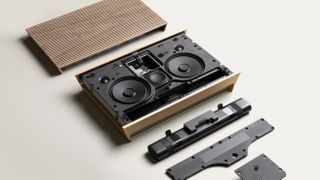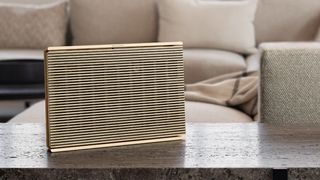This future-proof speaker shows modular tech isn't dead
Modular gadgets never truly succeeded, but Bang & Olufsen's new upgradable speaker shows a new way forward

When we think of tech’s big failures in the past decade, it’s easiest to gawp at a select few. The doomed Google Glass. The detonating Samsung Galaxy Note 7. Juicero, though that was kind of funny.
But by holding attention on these twelve-car pile-ups, we can often overlook the smaller tragedies. And this week the Bang & Olufsen Beosound Level reminded me of one in particular: modular tech.
- Our picks of the best Bluetooth speakers
- The best smart speakers you can buy
- Plus: Oppo could make the rear camera disappear
The idea was sound. People could buy a phone, a PC or even a TV and, instead of being stuck with the same hardware for the product’s entire lifespan, could swap in different modules to add functionality as it was needed.
Modular mediocrity
The Motorola Moto Z family was a prime example of the modular concept in action: you could clip on Moto Mods like extended battery packs, stereo speakers for better music playback, and even a 360-degree camera.
Then there was the Google Project Ara phone, in which almost every individual part could be added or removed to a cheap central skeleton. And who wouldn’t want a smartphone they can practically design and build themselves?
Very few, as it turns out. The Moto Mods concept kept trucking for a few years but now mainly exists as a clearance sale. Even before that, Project Ara was put to sleep in the face of a lack of manufacturer support and, frankly, an ugly, bulky design.
Likewise, the modular Acer Revo Build PC ended up as a singular, standalone product rather than kicking off a golden age of more easily upgradable PCs. More recent modular attempts haven’t convinced, either — the Razer Tomahawk isn’t significantly, structurally different from a PC you could build yourself. And Samsung’s idea of users creating a huge TV from smaller MicroLED screens sounds cost-prohibitive at best.
A sound plan
However, while the Beosound Level is also a pricey slice of smart speaker, I think it just might hold the blueprint for a more successful take on modular hardware. And, while it may sound counter-intuitive, I believe the secret lies in Bang & Olufsen keeping its ambitions small.
See, the Beosound Level’s modularity comes not from slapping it with bulky add-ons, but by making it easier to replace what’s already there. The battery, for instance, can be replaced by the user: an extremely rare quality of rechargeable home speakers, but one that potentially extends the working life beyond more locked-down rivals.
Then there’s the streaming module. Essentially all the Beosound Level’s Bluetooth, Wi-Fi and signal processing hardware is contained within a distinct module that, when current wireless technologies become obsolete, can be swapped out for faster and more reliable tech.
Since this enters the realm of future hypotheticals, you might call this forward-thinking to a fault, but the logic makes sense. Bluetooth 5.0 and Wi-Fi 6 aren’t going to be around forever, and if you can take advantage of something better without needing to buy a whole new speaker, that’s no bad thing.

But what makes the Beosound Level a more encouraging example of modular tech than, say, Project Ara, is that it makes the product just repairable and upgradable enough to provide a clear practical benefit without becoming downright alienating. Or, for that matter, even affecting the industrial design all that much.
Project Ara, with its chunky frame and multicolored chess board of module slots, must have looked somewhere between “a hassle” and “terrifying” to any casual users who just wanted a new phone. Moto Mods, meanwhile, required you carry around an arsenal of clip-on toys in addition to the handset itself. Suddenly the convenience of adding functionality doesn’t seem so convenient.
The Beosound Level, by contrast, just looks and acts like a modern wireless speaker, and a very good-looking one at that. Unless you actively choose to engage with the nerdy upgrade/repair aspect, there’s no sign that it even exists, even if it’s always there for those who want to take advantage.
This is why I’m glad modular hardware isn’t entirely dead, and a sign of where I hope it moves in the future. Not as a hyper-technical platform that excludes non-geeks, nor for turning PCs into building block toys, but as pragmatic method of making the products we buy stay useful for longer. And it’s all thanks to a wooden speaker.
Sign up to get the BEST of Tom’s Guide direct to your inbox.
Upgrade your life with a daily dose of the biggest tech news, lifestyle hacks and our curated analysis. Be the first to know about cutting-edge gadgets and the hottest deals.
James is currently Hardware Editor at Rock Paper Shotgun, but before that was Audio Editor at Tom’s Guide, where he covered headphones, speakers, soundbars and anything else that intentionally makes noise. A PC enthusiast, he also wrote computing and gaming news for TG, usually relating to how hard it is to find graphics card stock.
-
kep55 Future prof speakers? Get real. We're still using the speakers I bought in 1978 and they'll blow fuses and rattle rafters.Reply

